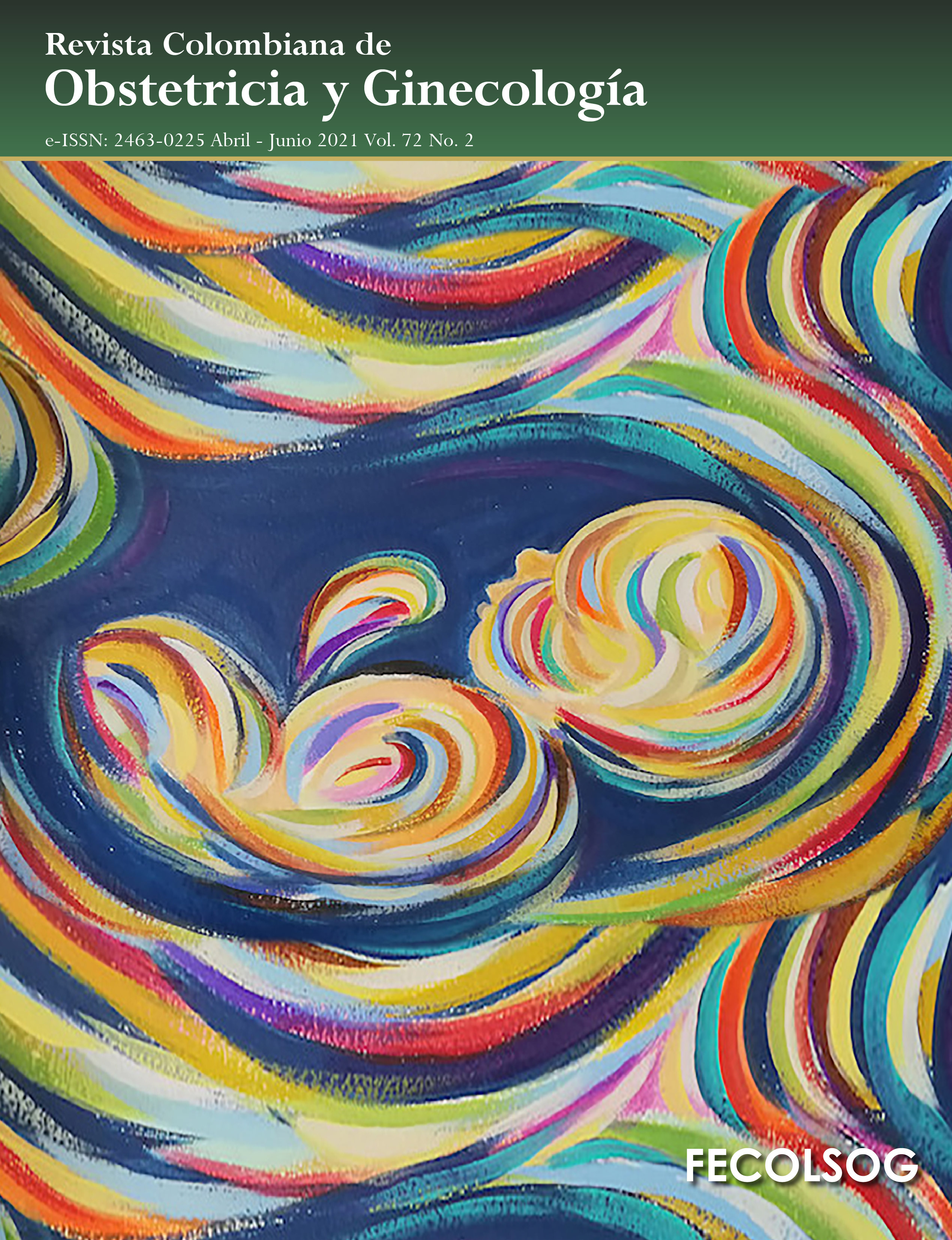Antenatal diagnosis of jejunal atresia by 3D HDlive ultrasound: Case report and literature review
DOI:
https://doi.org/10.18597/rcog.3607Abstract
Objectives: To report the case of a patient with a prenatal diagnosis of jejunal atresia and to review the literature regarding the results and prenatal diagnosis of this entity, implementing the use of non-conventional methods (3D ultrasound or magnetic resonance imaging). Material and methods: Report of a case of an 18-year-old pregnant woman referred to the Maternal-Fetal Medicine, Genetics and Reproduction Unit of the Virgen del Rocío Hospital in Seville due to fetus with abdominal peristaltic cystic image, consistent with jejunal atresia, confirmed with 3D HDLive mode ultrasound. A bibliographic search was carried out in Medline/PubMed, Google Scholar and LILACS, restricting by type of language (English and Spanish) and date of publication (January 1995 to June 2020). Primary studies of reports and case series relating to the outcome and prenatal diagnosis of this pathology were included. Results: The search identified 1,033 titles, of which four studies met the inclusion criteria, these being reports or case series. A total of twelve fetuses with a prenatal diagnosis of jejunal atresia detected with unconventional methods were reported. In all cases, the prenatal diagnosis was confirmed during the neonatal period, which required resection of the compromised segment; one of them died and two neonates developed short bowel syndrome because of a wide bowel resection. The postoperative course in the remaining cases was favorable. Conclusion: The available literature on the prenatal diagnosis of jejunal atresia using non-conventional methods is scarce and is limited to case reports or case series. The literature reviewed suggests that, in the presence of intestinal dilation, 3D ultrasound and magnetic resonance imaging could be of some use in characterizing the atretic portion and establishing the differential diagnosis. More studies are required to evaluate the diagnostic utility of these two alternatives.
Author Biographies
Ángel Chimenea-Toscano, Unidad de Medicina Materno-Fetal, Genética y Reproducción, Hospital Universitario Virgen del Rocío, Sevilla (España)
Unidad de Medicina Materno-Fetal, Genética y Reproducción, Hospital Universitario Virgen del Rocío, Sevilla (España); Fetal, IVF and Reproduction Simulation Training Centre (FIRST), Sevilla (España).
Lutgardo García-Díaz, Unidad de Medicina Materno-Fetal, Genética y Reproducción, Hospital Universitario Virgen del Rocío, Sevilla (España).
Unidad de Medicina Materno-Fetal, Genética y Reproducción, Hospital Universitario Virgen del Rocío, Sevilla (España).
Guillermo Antiñolo-Gil, Unidad de Medicina Materno-Fetal, Genética y Reproducción, Hospital Universitario Virgen del Rocío, Sevilla (España).
Unidad de Medicina Materno-Fetal, Genética y Reproducción, Hospital Universitario Virgen del Rocío, Sevilla (España); Fetal, IVF and Reproduction Simulation Training Centre (FIRST), Sevilla (España); Centro de Investigación Biomédica en Red de Enfermedades Raras (CIBERER), Sevilla (España).
References
Barnewolt CE. Congenital abnormalities of the gastrointestinal tract. Semin Roentgenol. 2004;39:263‐81. https://doi.org/10.1053/j.ro.2004.02.002
Anomalies of the gastrointestinal tract and the abdominal wall. En: Paladini D, Volpe P, editores. Ultrasound of congenital fetal anomalies. Taylor and Francis Group, 2014. Pp. 267-306. https://doi.org/10.1201/b16779-8
Haeusler MC, Berghold A, Stoll C, Barisic I, Clementi M; EUROSCAN Study Group. Prenatal ultrasonographic detection of gastrointestinal obstruction: results from 18 European congenital anomaly registries. Prenat Diagn. 2002;22(7):616-23. https://doi.org/10.1002/pd.341
Tonni G, Grisolia G, Granese R, Giacobbe A, Napolitano M, Passos JP, et al. Prenatal diagnosis of gastric and small bowel atresia: A case series and review of the literature. J Matern Fetal Neonatal Med. 2016;29(17):2753-61.
John R, D'Antonio F, Khalil A, Bradley S, Giuliani S. Diagnostic accuracy of prenatal ultrasound in identifying jejunal and ileal atresia. Fetal Diagn Ther. 2015;38(2):142‐6. https://doi.org/10.1159/000368603
Wax JR, Hamilton T, Cartin A, Dudley J, Pinette MG, Blackstone J. Congenital jejunal and ileal atresia: Natural prenatal sonographic history and association with neonatal outcome. J Ultrasound Med. 2006;25(3):337‐42. https://doi.org/10.7863/jum.2006.25.3.337
AboEllail MA, Tanaka H, Mori N, Hanaoka U, Hata T. HDlive silhouette mode in antenatal diagnosis of jejunal atresia. Ultrasound Obstet Gynecol. 2016;48(1):131‐2. https://doi.org/10.1002/uog.15737
Werner H, Macedo N, Fazecas T, Nogueira R, Daltro P, Castro P, et al. Prenatal diagnosis of jejunal atresia by 3-D ultrasonography and MRI. J Obstet Gynaecol Can. 2019;41(11):1529‐30. https://doi.org/10.1016/j.jogc.2018.06.022
Rubio EI, Blask AR, Badillo AT, Bulas DI. Prenatal magnetic resonance and ultrasonographic findings in small-bowel obstruction: Imaging clues and postnatal outcomes. Pediatr Radiol. 2017;47(4):411‐21. https://doi.org/10.1007/s00247-016-3770-0
How to Cite
Downloads
Downloads
Published
Issue
Section
| Article metrics | |
|---|---|
| Abstract views | |
| Galley vies | |
| PDF Views | |
| HTML views | |
| Other views | |
















